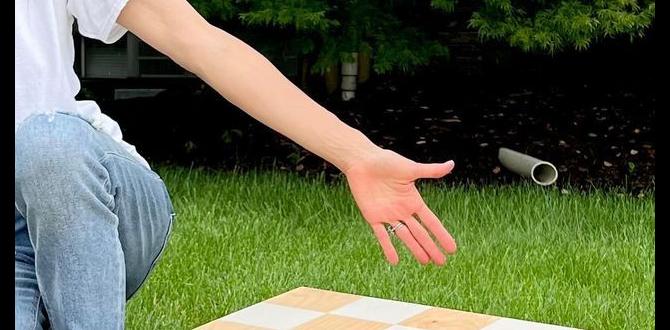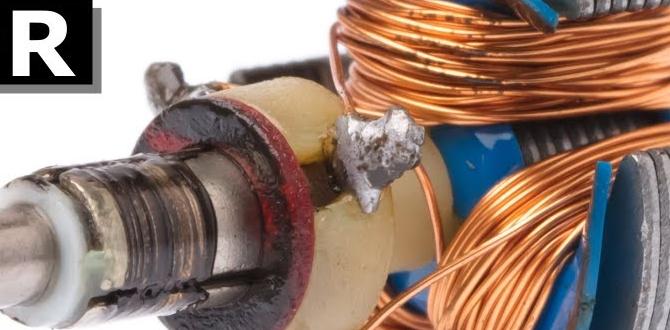Quick Summary:
Learn how to use a coil siding nailer safely and effectively with this beginner-friendly guide. Master loading, operating, and maintenance for impressive siding projects. Get your siding project done right and looking professional with this essential tool.
Hey there, DIYers! Jack Shaffer here from Nailerguy. Ever looked at a beautifully finished siding job and thought, “That looks tough!”? It doesn’t have to be. One of the biggest helpers for this kind of work is the coil siding nailer. It might seem a little intimidating at first, with its coiled nails and powerful action, but I promise, once you get the hang of it, you’ll wonder how you ever tackled siding without one. We’ll break it down step-by-step.
This guide is all about making you feel confident and ready to use your coil siding nailer. We’ll cover everything from setting it up to nailing your first piece of siding, and even some tips to keep it running smoothly. Stick with me, and by the end of this, you’ll be ready to transform your home’s exterior.
Table of Contents
What is a Coil Siding Nailer and Why Use One?
So, what exactly is this handy tool we’re talking about? A coil siding nailer is a specialized power tool designed specifically for installing siding on buildings. Unlike framing nailers that use straight strips of nails, a coil siding nailer uses nails that are held together in a coil, almost like a spring. This unique design means the tool can hold a lot more nails at once – sometimes over 400! This is a huge advantage when you’re working on large areas like the exterior of your house.
Why choose a coil siding nailer for your project? For starters, there’s the efficiency. Because it holds so many nails, you spend much less time reloading and more time nailing. This can drastically speed up your siding installation. Think about it: fewer interruptions mean a quicker project completion. Plus, they are designed to drive nails at the correct depth for siding, helping to prevent damage to the material and ensuring a secure hold. They are typically used for materials like vinyl, aluminum, and fiber cement siding.
Using the right tool for the job makes all the difference. A coil siding nailer is built for this specific task, making it more efficient and often resulting in a cleaner, more professional-looking finish than trying to do it manually or with a less specialized tool. It’s about working smarter, not harder, and getting a great result.
Types of Coil Siding Nailers
Before we dive into using one, it’s good to know there are a few main types of coil siding nailers you might encounter. The biggest difference usually comes down to what powers them.
- Pneumatic Coil Siding Nailers: These are the most common type you’ll find. They run on compressed air from an air compressor. They offer great power and are generally lighter than other types, which can be a big plus when you’re holding the tool overhead or for extended periods. You’ll need an air compressor and an air hose to use these.
- Cordless (Battery-Powered) Coil Siding Nailers: These are becoming very popular. They run on rechargeable batteries, offering maximum portability. You don’t need a compressor or hose, making them super convenient for quick jobs or working in remote areas. The trade-off can be a bit more weight due to the battery and potentially slightly less power for very tough materials compared to high-end pneumatic models.
- Gas-Powered Coil Siding Nailers: Less common for siding specifically but seen in some construction contexts. These use a combination of a fuel cell and a battery. They provide lots of power and portability but come with the ongoing cost of fuel cells and can have exhaust fumes.
For most DIYers tackling home siding projects, a pneumatic or a battery-powered coil siding nailer will be your best bet. Each has its advantages, so consider your project size, budget, and whether you already own an air compressor when making your choice.
Essential Tools and Materials You’ll Need
To get the most out of your coil siding nailer and ensure a smooth project, you’ll want to have a few things ready. It’s always better to be prepared!
For the Nailer Itself:
- Coil Siding Nails: This is crucial! You need the right type and size of nails for your siding material. Check your siding manufacturer’s recommendations. For example, vinyl siding often uses specific nails that won’t cause it to buckle. Always use nails designed for siding, not general-purpose construction nails.
- Air Compressor and Hose (for Pneumatic Nailers): Make sure your compressor can provide the required PSI (pounds per square inch) and CFM (cubic feet per minute) for your nailer. A good quality air hose of sufficient length is also important.
- Battery and Charger (for Cordless Nailers): Ensure the battery is fully charged before you start.
For Your Safety:
- Safety Glasses or Goggles: Non-negotiable! Always protect your eyes from flying debris or nail fragments.
- Work Gloves: To protect your hands and provide a better grip.
- Hearing Protection: Nail guns can be loud, especially when used repeatedly. Earplugs or earmuffs are a good idea.
- Sturdy Footwear: You’ll likely be on ladders or uneven ground, so good traction is important.
For the Siding Project:
- Your Siding Material: Whatever you’re installing (vinyl, fiber cement, etc.).
- Measuring Tape: For accurate cuts and placement.
- Utility Knife or Siding Shears: For cutting siding panels.
- Pencil or Marker: For marking cuts.
- Level: Essential for ensuring your siding is straight.
- Hammer: For tapping in nails if needed or for minor adjustments.
- Caulk Gun and Exterior Caulk: For sealing gaps and edges.
- Ladder or Scaffolding: If working at height.
Having all of this ready before you begin will save you a lot of frustration and keep your project moving efficiently.
How to Prepare Your Coil Siding Nailer
Getting your nailer ready is the first hands-on step. This is where you make sure everything is set up correctly and safely. Taking a few minutes here will prevent problems down the line.
Step 1: Read Your Tool’s Manual
This is the golden rule for any tool, and nailers are no exception. Every nailer is slightly different. Your manual will have specific instructions for loading, operation, and safety for your model. Seriously, don’t skip this!
Step 2: Connect to Air (Pneumatic Nailers)
If you’re using a pneumatic nailer, make sure your air compressor is turned off and drained of any excess moisture. Connect the air hose securely to the nailer’s air inlet. Then, turn on your compressor and set the pressure. This is super important. Too little pressure and the nail won’t drive properly; too much and you risk damaging the siding or the nailer. Check your nailer’s manual for the recommended operating pressure – it’s usually between 70-100 PSI.
Step 3: Load the Nails
This is where the “coil” part comes in. Coil siding nailers have a magazine that swivels or opens up to accept the coil of nails.
- Open the Magazine: Typically, there’s a lever or latch you’ll need to press or slide to open the magazine.
- Insert the Coil: Place the coil of nails into the designated slot. Make sure the wire connecting them is facing the correct direction so it feeds smoothly into the nose of the nailer. Some nailers have specific guides or ways the coil needs to sit, so refer to your manual.
- Close the Magazine: Once the coil is seated correctly, close the magazine securely until it latches.
- “Bump” the Nailer: To engage the first nail, you’ll typically need to dry fire it once or twice (away from any material, of course) or gently bump the nose against a scrap piece of wood. This drives the first nail into the feeder mechanism.
Step 4: Adjust Depth Setting (If Applicable)
Many siding nailers have an adjustable depth setting. This allows you to control how deep the nail is driven into the siding. You want the nail head to sit flush with the surface of the siding, or slightly countersunk, but not so deep that it crushes or damages the material. Experiment on a scrap piece of your siding material to find the perfect setting. A nail driven too shallow can pop out, and one driven too deep can split the siding or leave an unsightly dimple.
Step 5: Safety Check
Before you even think about firing a nail into your project, do a final safety check. Ensure your safety glasses are on, you have good footing, and the area around you is clear. Make sure there’s no one behind the target area. A quick check goes a long way in preventing accidents.
How to Use the Coil Siding Nailer Safely and Effectively
Now that your nailer is prepped, let’s get to the exciting part: nailing! Safety and proper technique are key here for a good outcome and to avoid any mishaps.
Understanding Nailer Modes: Sequential vs. Contact Actuation
Most siding nailers offer at least two firing modes. Knowing which one to use and how they work is vital for safety and efficiency.
- Sequential Mode (Or “Single Fire”): In this mode, you must first pull the trigger and then press the nose of the nailer against the surface you want to nail. This is the safest mode and recommended for precise placement, especially when you’re starting out or working around edges and difficult spots. It prevents accidental firing.
- Contact Actuation Mode (Or “Bump Fire”): In this mode, you can keep the trigger pulled and then simply bump the nose of the nailer against the surface to fire a nail. This mode is much faster for general nailing and can speed up your work considerably once you are comfortable and proficient. However, it requires more control to avoid accidental nail firing, making it less ideal for beginners or delicate areas. Always use sequential mode first until you are very comfortable and have practiced.
Check your tool’s manual to see how to switch between these modes, usually via a selector switch near the trigger.
The Siding Nailing Process: Step-by-Step
Here’s how to actually drive those nails!
- Position the Siding: Place your siding panel exactly where you want it. Use your level to ensure it’s straight. For specific siding types, you might need to account for expansion gaps or specific overlap requirements. Always consult your siding manufacturer’s installation guide.
- Place the Nailer: Position the nose of the nailer firmly against the siding. Make sure it’s perpendicular to the surface for a straight nail drive. The nose needs to be placed on a solid part of the siding that will be covered or secured by the overlap of the next piece. Do NOT place the nose on the edge of a nail hem or where it could split the siding. You typically want to nail into the stud or the nailing strip provided in the siding design.
- Fire the Nail:
- In Sequential Mode: First, firmly press the nose of the nailer against the siding. Only then pull the trigger.
- In Contact Actuation Mode: Keep the trigger pulled. Firmly press the nose against the siding. The nail will fire. Release the trigger after firing if you only want one nail.
- Check the Nail Depth: After firing, visually inspect the nail. Is the head flush with the siding surface? If it’s too high, it might not hold well or could snag. If it’s too low and has punched through or crushed the siding, you’ve driven it too deep. Adjust the depth setting on your nailer and try again on a scrap piece.
- Drive Nails in Pattern: For most siding, you’ll install a few nails along the length of a panel, spaced according to the manufacturer’s recommendations. These nails are often driven into pre-drilled holes or specific nailing zones designed to allow for expansion and contraction of the material due to temperature changes. Never drive nails so tight that the siding cannot move; this can cause buckling. A common guideline for vinyl siding, for example, is to drive nails through the center of the slots, about 6 inches apart, and to avoid nailing them so tight that the panel cannot be moved slightly by hand.
- Move to the Next Nail/Panel: Once you’ve nailed one panel according to specifications, release pressure on the nose (if in sequential mode) and move the nailer to the next nailing location or the next panel.
Important Siding Nailing Tips:
- Test on Scrap Material: Always, always, always test your nailer’s depth and pressure on a spare piece of your siding material before you start on the house. This is critical for getting the setting just right.
- Maintain a Firm Grip: Hold the nailer firmly but without excessive force. A steady grip helps ensure accurate placement and reduces fatigue.
- Keep the Nailer Perpendicular: Driving nails at an angle can cause them to bend, miss the intended target, or not hold securely.
- Don’t Over-Nail: Follow the siding manufacturer’s instructions for nail spacing. Over-nailing can restrict the siding’s natural movement, leading to cracking or buckling, especially with temperature changes.
- Clear Debris: Keep the work area and the nose of the nailer free of dust and debris, which can interfere with operation.
- Watch for Obstructions: Be aware of what’s behind the siding where you’re nailing. You don’t want to drive a nail into a wire or pipe.
Troubleshooting Common Coil Siding Nailer Problems
Even with the best tools, you might run into a snag. Here are some common issues and how to fix them.
Problem: Nail Not Firing
- Possible Cause: No air pressure (pneumatic).
- Solution: Check if the air compressor is on and the hose is properly connected. Ensure the pressure is set correctly.
- Possible Cause: Nailer safety mechanism engaged or not properly seated.
- Solution: Ensure the nose piece is pressed firmly against a surface. Check that the magazine is fully closed and latched.
- Possible Cause: Out of nails or nails not loaded correctly.
- Solution: Reload the nail coil, ensuring it’s seated properly and the first nail is engaged.
- Possible Cause: Low battery (cordless).
- Solution: Charge or replace the battery.
Problem: Nail Not Driving Fully / Under-driving
- Possible Cause: Insufficient air pressure (pneumatic).
- Solution: Increase the air pressure from the compressor. Ensure your compressor is keeping up with the nailer’s demands (CFM rating).
- Possible Cause: Depth adjustment set too high.
- Solution: Adjust the depth setting counter-clockwise (usually) to allow the nail to drive deeper.
- Possible Cause: Worn driver blade or O-rings inside the nailer.
- Solution: This might require maintenance or professional service.
Problem: Nail Driving Too Deep / Over-driving
- Possible Cause: Depth adjustment set too low.
- Solution: Adjust the depth setting clockwise (usually) to prevent the nail from driving too deep.
- Possible Cause: Air pressure too high (pneumatic).
- Solution: Reduce the air pressure from the compressor.
Problem: Nail Jamming
This is probably the most frustrating issue. Most coil siding nailers have a way to clear jams, often through a nose latch or by removing a small plate.
- Solution:
- DISCONNECT POWER FIRST! For pneumatic, disconnect the air hose. For cordless, remove the battery.
- Locate the jam-clearing mechanism. This is usually on the side or front of the nailer’s magazine.
- Follow your tool’s manual instructions for opening the jam-clearing access.
- Carefully remove the jammed nail using pliers if necessary.
- Once clear, reassemble any parts, reconnect power, and test on scrap material again.
Important: Always refer to your specific nailer’s manual for detailed troubleshooting and jam-clearing procedures. Forcing these parts can cause damage.
Coil Siding Nailer Maintenance for Longevity
A little bit of care goes a long way in keeping your coil siding nailer working reliably for years.
Regular Cleaning:
- After each use, wipe down the exterior of the nailer with a clean cloth.
- Remove any dust, wood shavings, or



